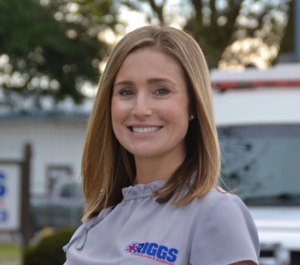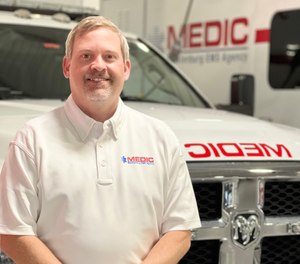California Human Resources | Changes to CA Paid Sick Leave Law
Please either or Join!
Please either or Join!
Limited options for professional growth and the lack of a clear career path are barriers to recruitment, retention and career longevity.
The EMS Burnout Repair Kit series, presented by EMS1 and Zoll, equips individuals at all levels in EMS with tools for dealing with the primary sources of burnout, helping them emerge as better, happier providers and more complete people.
In this installment, a panel comprised of individuals representing different career paths in EMS and leaders from progressive agencies will discuss resources for career advancement and resiliency, how to find the path that is right for you, and how agencies can support providers in advancing their careers.
Join the live discussion, March 1 at 1 p.m. CT
Carly Alley

Carly Alley is the executive director for Riggs Ambulance Service in Merced, California. Earlier in her career, Alley served as a firefighter-EMT in the U.S. Forest Service while earning her paramedic certification. After being hired by Riggs, she transitioned to the agency’s tactical EMS program, where she spent 10 years as the team leader before moving into administration.
Michael Fraley, BS, BA, NRP
-1.png?w=300&format=jpg&quality=87&crop=28%2C0%2C300%2C265)
Michael Fraley has over 25 years of experience in EMS in a wide range of roles, including flight paramedic, EMS coordinator, service director and educator. Fraley began his career in EMS while earning a bachelor’s degree at Texas A&M University. He also earned a BA in business administration from Lakeland College.
When not working as a paramedic or the coordinator of a regional trauma advisory council, Michael serves as a public safety diver and SCUBA instructor in northern Wisconsin.
John (JP) Peterson, MS, MBA

JP Peterson is the newly appointed executive director at Mecklenburg EMS Agency (MEDIC) in Charlotte, North Carolina. He started his career as an EMT in Chicago in 2000 and most recently served as vice president of Florida operations for PatientCare EMS Solutions.
He is licensed as a paramedic in Florida and North Carolina, and holds National Board Certification as an occupational therapist. He has completed Six Sigma Yellow Belt certification and is a graduate of the American Ambulance Association, Ambulance Service Manager Course. JP received the Pinellas County Commissioner, John Morroni Award for first responders in 2013.
JP is a past president of the Florida Ambulance Association. He is a member of the North Carolina Association of EMS Administrators as well as the AAA Bylaws, Professional Standards and Ethics committees.
Our hearts are broken for the families, colleagues, and friends of those impacted.
From EMS1 on July 14 by AAA Communications Chair Rob Lawrence
Fifty years ago, on July 15, 1970, then California Governor Ronald Reagan signed into law the Wedworth-Townsend Paramedic Act. The law created the conditions for the establishment of the first accredited paramedic training program in the United States.
The story of American paramedicine did not begin in California or even in the U.S., but in Belfast, Northern Ireland. The inspiration for this program came from World War II era British Royal Army Medical Corps (RAMC) Medical Officer, Professor Frank Pantridge, MD.
40 Under 40 nominees were selected based on their contributions to the American Ambulance Association, their employer, state ambulance association, other professional associations, and/or the EMS profession.
____

____
LinkedIn
Nominated by: Steve Grau (Royal Ambulance – San Leandro, CA)
____
Hasieb Lemar has been with Royal Ambulance for over 13 years. Hasieb’s experience includes time as a Field EMT, after which he was promoted to Field Training Officer, Operations Supervisor, Director of Operations, Vice President of Operations, and to his current role of Chief Operating Officer. Having risen through the ranks at Royal Ambulance, and being an integral part of the organization’s growth and development, Hasieb has played a critical role in shaping and developing future healthcare leaders with an emphasis on compassionate patient care. Versatile, innovative, and service oriented, Hasieb has a proven track record of successfully driving operational efficiency while maximizing business opportunities and revenue growth. Hasieb earned his degree in Criminal Justice from Cal State Hayward located in Hayward, CA where he grew up and still resides with his wife and daughter.
____
Hasieb Lemar has risen through the ranks at Royal Ambulance, starting as an EMT in 2007, to becoming the first Chief Operating Officer at Royal Ambulance at the young age of 33 in 2019. Hasieb’s impact can’t be understated or expressed in a few short paragraphs. Driven by being a servant leader, he works tirelessly to mentor our growing team of managers and supervisors, cascading his impact to hundreds of young EMTs who serve the Bay Area communities and who have developed to become Nurses, Physicians Assistants, Firefighters, and Doctors.
Hasieb’s legendary work ethic embodies Royal’s organizational core values of being Adaptable, Driven, Engaging, and Empathetic. Hasieb has led Royal’s progressive growth from just a few ambulances running a dozen transports a day to one of California’s premier mobile health care providers, transporting over 65,000 patients a year and earning multiple recognitions as one of INC Magazine’s fastest-growing companies in the United States.
Among many awards, the one most reflective of Hasieb’s leadership is the designation of Royal Ambulance as Best Company to Work For in the US by Modern Healthcare. Hasieb’s focus on employee engagement and career development alongside process improvements and patient experience have produced superior operational, financial, and clinical results.
Hasieb spearheaded the development of Royal’s partnership with the Organ Donor Network West & San Ramon Medical Center in creating the Donor Recovery Intra-Facility Transport (DRIFT) Program. Building the program from the ground up, the team has been able to improve access to donors across Northern California and most importantly reduced precious time to provide life-saving transplants to hundreds of patients. While working with the Organ Donor Network, Hasieb presented at the University of Wisconsin to help launch a pilot program. Since Royal’s own program-launch three years ago, Royal has traveled over 67,000 miles serving the Organ Donor Network. Due to Hasieb’s efforts, countless patients have been given a new chance at a new life.
When Hasieb is not working, he is a dedicated father and husband, who finds time to serve on various committees in his home city of Hayward, including the Keep Hayward Green Task Force. Hasieb also volunteers his time on the Data and Operations Committee for the California Ambulance Association.
Royal Ambulance and the community we serve would not be the same without Haiseb’s leadership. A trusted advisor, mentor, coach, and friend; everyone and anyone who meets Hasieb and has the privilege to work alongside him, feel supported, encouraged and know he has their back no matter what.
____
View all of the 2020 Mobile Healthcare 40 Under 40 Honorees
The American Ambulance Association is proud to announce the recipients of the 2018 AMBY Awards. The AMBYs highlight excellence in EMS and the ingenuity and entrepreneurial spirit that epitomize AAA members. The mission of the awards is to showcase creativity and innovation in the ambulance industry by fostering a culture of collaboration, cooperation and a passion for excellence in patient care. This year’s awards will be presented at the Annual Conference & Trade Show Awards Reception on September 7, 2018. Please join us in congratulating our 2018 winners!
Medic Ambulance Service, Inc. | Vallejo, CA
NorthStar EMS, Inc. | Tuscaloosa, AL
Hall Ambulance Service, Inc. | Bakersfield, CA
Priority Ambulance | Knoxville, TN
Mercy Ambulance Service, Inc. | Savannah, GA
MEDIC EMS Agency | Charlotte, NC
Hall Ambulance Service, Inc. | Bakersfield, CA
Sunstar Paramedics | Largo, FL
Priority Ambulance | Knoxville, TN
Once again, join us in celebrating the 2018 winners! Learn more about the AMBYs.
The AAA would like to take this opportunity to update members on a number of issues related to Medicare reimbursement:
Have any questions about these updates? Contact Brian Werfel at bwerfel@aol.com
The House VA Committee hearing started at 7:30 p.m., but it was well-attended and lasted until 10 p.m. The witnesses included Senator John McCain (R-AZ), VA Secretary David Shulkin, and representatives of the VA Office of Inspector General and the Government Accountability Office. Senator McCain and Secretary Shulkin were both warmly welcomed by Members of the Committee on a bipartisan basis.
Chairman Roe (R-TN) emphasized the need to act quickly to extend the authorization for the Veterans Choice Program, which expires on August 7. To that end, the House VA Committee is voting today on a bill to eliminate the sunset of the program’s authorization. In addition, the Committee will consider broader legislation later this year to make comprehensive reforms to the Choice Program. He noted that the VA has additional funds available but will not be able to spend them once the authorization expires. A copy of Chairman Roe’s opening statement is available here.
Secretary Shulkin testified in support of extending the Choice Program, and he clarified that the VA was not seeking additional funding – just the authority to spend funds already obligated. He noted that the VA already is being forced to deny Choice Program coverage to veterans whose episodes of care would extend beyond the August 7 expiration date (e.g., pregnancy).
Secretary Shulkin also urged Congress to support the VA’s efforts to bring appointment scheduling in-house for care coordination purposes. However, the VA OIG witness noted challenges in records going out to community-based providers and coming back to the VA. The GAO witness also underscored the need for the VA to have better systems in place in order to effectively coordinate care, which will take time to procure and implement. Rep. Brownley (D-CA) echoed that point, calling the VA’s information technology systems a “Model T in a Tesla world.” Rep. Esty (D-CT) also urged improvements in the VA’s information systems and expressed concern that veterans are being improperly billed.
Other Members, including Rep. Wenstrup (R-OH) and Rep. Poliquin (R-ME), raised concerns about continuing delays in the processing of claims and payments to providers. Secretary Shulkin agreed that providers deserve to be paid for their services, noting his own experience as a physician in the private sector. He acknowledged that the VA is not processing enough claims electronically today, and he advised that he plans to pursue options outside the VA for systems procurement going forward.
Many Members also raised serious concerns about treatment of PTSD and mental health conditions for veterans, including Rep. Wenstrup (R-OH), Rep. O’Rourke (D-TX), Rep. Sablan (D-MP), Rep. Banks (R-IN), Rep. Rutherford (R-FL) and Rep. Takano (D-CA). Rep. O’Rourke emphasized that suicide among veterans is the most serious crisis, and Secretary Shulkin agreed that it is his number one priority. The Secretary announced that the VA will begin providing urgent mental health care that also will include individuals other than those service members who were honorably discharged. He added that the VA needs 1,000 more mental health providers, as well as telemental health services, and is looking to expand community partnerships to address suicide.
Rep. Banks noted interest among Indiana veterans in greater access to alternative treatments for PTSD and traumatic brain injury. Secretary Shulkin underscored that he is “most concerned about areas like PTSD, where we do not have effective treatments.” He also advised that the VA has established an “Office of Compassionate Innovation” (separate from the VA’s Center for Innovation), which will focus on finding new approaches to health and physical wellness and explore alternative treatment options for veterans when traditional methods fall short.
Rep. Wenstrup inquired about the VA’s GME and residency programs, as well as its associations with academic institutions. Secretary Shulkin responded that the VA is “doubling down” on partnerships with academic medical institutions.
Chairman Roe concluded his remarks by emphasizing the need to extend the Choice Program authorization soon and to consolidate the VA’s community-based care programs. He also expressed support for the VA’s decision to stop developing its own information technology internally.